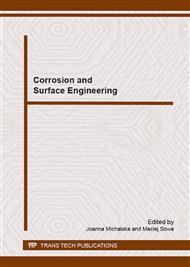[1]
Z. Yang, H. Fischer, R. Polder, Modified hydrotalcites as a new emerging class of smart additive of reinforced concrete for anticorrosion applications: A literature review, Mater. Corros. 64 (2013) 1-9.
DOI: 10.1002/maco.201206915
Google Scholar
[2]
A. Królikowski, J. Kuziak, Impedance study on calcium nitrite as a penetrating corrosion inhibitor for steel in concrete, Electrochim. Acta 56 (2011) 7845-7853.
DOI: 10.1016/j.electacta.2011.01.069
Google Scholar
[3]
A. Legat, Monitoring of steel corrosion in concrete by electrode arrays and electrical resistance probes, Electrochim. Acta 52 (2007) 7590-7598.
DOI: 10.1016/j.electacta.2007.06.060
Google Scholar
[4]
M.A.G. Tommaselli, N.A. Mariano, S.E. Kuri, Effectiveness of corrosion inhibitors in saturated calcium hydroxide solutions acidified by acid rain components, Construct. Build. Mater. 23 (2009) 328-333.
DOI: 10.1016/j.conbuildmat.2007.12.002
Google Scholar
[5]
J.O. Okeniyi, O.A. Omotosho, O.O. Ajayi, O.O. James, C.A. Loto, Modelling the performance of sodium nitrite and aniline as inhibitors in the corrosion of steel-reinforced concrete, Asian J. Appl. Sci. 5 (2012) 132-143.
DOI: 10.3923/ajaps.2012.132.143
Google Scholar
[6]
J.O. Okeniyi, O.A. Omotosho, O.O. Ajayi, C.A. Loto, Effect of potassium-chromate and sodium-nitrite on concrete steel-rebar degradation in sulphate and saline media, Construct. Build. Mater. 50 (2014) 448-456.
DOI: 10.1016/j.conbuildmat.2013.09.063
Google Scholar
[7]
J.O. Okeniyi, I.O. Oladele, I.J. Ambrose, S.O. Okpala, O.M. Omoniyi, C.A. Loto, A.P.I. Popoola, Analysis of inhibition of concrete steel-rebar corrosion by Na2Cr2O7 concentrations: Implications for conflicting reports on inhibitor effectiveness, J. Cent. South Univ. 20 (2013).
DOI: 10.1007/s11771-013-1898-8
Google Scholar
[8]
J. –J. Fu, S. –N. Li, L. –H. Cao, Y. Wang, L. –H. Yan, L. –D. Lu, L-Tryptophan as green corrosion inhibitor for low carbon steel in hydrochloric acid solution, J. Mater. Sci. 45 (2010) 979-986.
DOI: 10.1007/s10853-009-4028-0
Google Scholar
[9]
M.M. Mennucci, E.P. Banczek, P.R.P. Rodrigues, I. Costa, Evaluation of benzotriazole as corrosion inhibitor for carbon steel in simulated pore solution. Cem. Concr. Compos. 31 (2009) 418-424.
DOI: 10.1016/j.cemconcomp.2009.04.005
Google Scholar
[10]
T. Oduola, I. Bello, G. Adeosun, A. –W. Ademosun, G. Raheem, G. Avwioro, Hepatotoxicity and nephrotoxicity evaluation in Wistar albino rats exposed to Morinda lucida leaf extract, N. Am. J. Med. Sci. 2 (2010) 230-233.
Google Scholar
[11]
S. Muralidharan, V. Saraswathy, S.P. Merlin Nima, N. Palaniswamy, Evaluation of a composite corrosion inhibiting admixtures and its performance in Portland pozzolana cement, Mater. Chem. Phy. 86 (2004) 298–306.
DOI: 10.1016/j.matchemphys.2004.03.025
Google Scholar
[12]
ASTM G109-99a. Standard test method for determining the effects of chemical admixtures on the corrosion of embedded steel reinforcement in concrete exposed to chloride environments, ASTM International, West Conshohocken, PA.
DOI: 10.1520/g0109-99a
Google Scholar
[13]
ASTM C192/192M-02. Standard practice for making and curing concrete test specimens in the laboratory, ASTM International, West Conshohocken, PA.
Google Scholar
[14]
J.O. Okeniyi, I.J. Ambrose, S.O. Okpala, O.M. Omoniyi, I.O. Oladele, C.A. Loto, P.A.I. Popoola, Probability density fittings of corrosion test-data: Implications on C6H15NO3 effectiveness on concrete steel-rebar corrosion. Sadhana – Acad. Proc. Eng. Sci. (2013).
DOI: 10.1007/s12046-014-0226-9
Google Scholar
[15]
J.O. Okeniyi, I.J. Ambrose, I.O. Oladele, C.A. Loto, P.A.I. Popoola, Electrochemical performance of sodium dichromate partial replacement models by triethanolamine admixtures on steel-rebar corrosion in concretes, Int. J. Electrochem. Sci. 8 (2013).
DOI: 10.1016/s1452-3981(23)13146-4
Google Scholar
[16]
J.O. Okeniyi, O.M. Omoniyi, S.O. Okpala, C.A. Loto, A.P.I. Popoola, Effect of ethylenediaminetetraacetic disodium dihydrate and sodium nitrite admixtures on steel-rebar corrosion in concrete. Euro. J. Environ. Civ. Eng. 17 (2013) 398-416.
DOI: 10.1080/19648189.2013.797927
Google Scholar
[17]
D. Izquierdo, C. Alonso, C. Andrade, M. Castellote, Potentiostatic determination of chloride threshold values for rebar depassivation Experimental and statistical study, Electrochim. Acta 49 (2004) 2731-2739.
DOI: 10.1016/j.electacta.2004.01.034
Google Scholar
[18]
P.R. Roberge, Statistical interpretation of corrosion test results, in: S.D. Cramer, B.S. Covino Jr., (Eds. ), ASM Handbook, Vol 13A – Corrosion: Fundamentals, Testing, and Protection, Materials Park, OH: ASM International, 2003, pp.425-429.
DOI: 10.31399/asm.hb.v13a.a0003641
Google Scholar
[19]
ASTM G16-95 R04. Standard guide for applying statistics to analysis of corrosion data, ASTM International West Conshohocken PA.
Google Scholar
[20]
J.O. Okeniyi, U.E. Obiajulu, A.O. Ogunsanwo, N.W. Odiase, E.T. Okeniyi, CH4 emission model from the waste of Sus domesticus and Gallus domesticus in Nigerian local farms: Environmental implications and prospects, Mitig. Adapt. Strateg. Glob. Chang. 18 (2013).
DOI: 10.1007/s11027-012-9365-7
Google Scholar
[21]
J.O. Okeniyi, E.T. Okeniyi Implementation of Kolmogorov-Smirnov p-value computation in Visual Basic®: implication for Microsoft Excel® library function, J. Stat. Comput. Simul. 82 (2012) 1727-1741.
DOI: 10.1080/00949655.2011.593035
Google Scholar
[22]
A.L. d.Q. Baddini, S.P. Cardoso, E. Hollauer, J.A. d.C.P. Gomes, Statistical analysis of a corrosion inhibitor family on three steel surfaces (duplex, super-13 and carbon) in hydrochloric acid solutions, Electrochim. Acta 53 (2007) 434-446.
DOI: 10.1016/j.electacta.2007.06.050
Google Scholar
[23]
ASTM C876-91 R99. Standard test method for half-cell potentials of uncoated reinforcing steel in concrete, ASTM International, West Conshohocken, PA.
Google Scholar
[24]
T.A. Söylev, M.G. Richardson, Corrosion inhibitors for steel in concrete: State-of-the-art report, Construct. Build. Mater. 22 (2008) 609-622.
DOI: 10.1016/j.conbuildmat.2006.10.013
Google Scholar


